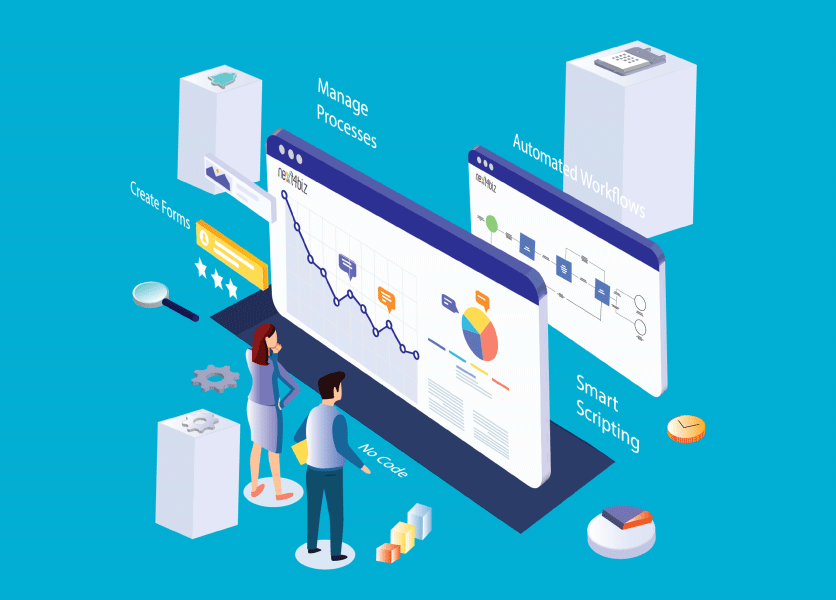
Let’s take a look at what business process management is and isn’t to better understand the BPM discipline. To do so, we will take a step back and consider business process management from a slightly broader perspective.

The concept of business process management goes back a long time. Pioneers in the field date back to the Industrial Revolution. In the business landscape of the time, BPM was more about creating a methodical management approach. At most, it theorized that other methods and tools could exist with which to run things “better.”
Fast forward to the early 2000s, when the business process management software industry had finally agreed on the general definition of process management methodology and established a more concrete scope.
What is BPM?
Additionally, in the business process management approach, the leadership of business units in management is brought to the forefront. The main business units in an organization, especially those in constant contact with customers, should be the primary actors in making decisions on business operations. BPM represents the way these actors see and run things end-to-end. After all, these users have the most accurate vision of operations in the organization.
Organizational development is another focus area of BPM. Business process management lays the groundwork for promoting a culture of continuous improvement within a team or organization.
This means that after an organization defines all its processes with business process management and begins to run its processes accordingly, the organization’s ability to use daily business tools or business knowledge – corporate intelligence – will constantly evolve and sharpen, resulting in a continuous increase in efficiency, reduced costs, and time savings.
What isn’t BPM?
Now let’s take a look at what BPM isn’t. Business process management is not purely a process improvement methodology. BPM forms the basis for defining, updating, and managing the processes within an organization; however, it is not a standalone process improvement methodology. Different methodologies are used simultaneously in the business management discipline. That is why BPM should not be defined entirely as a “process improvement methodology.”

Contrary to popular belief, business process management is not a solution used exclusively in IT processes. This misconception comes from the idea that business process management is solely technical software. While this might have been true of past business process management software (in which process design and operations were carried out with solutions developed by coding), thanks to the development of low-code or even no-code platforms, business process management is now predominantly managed by business units.
Another misconception is that business process management software is a tactical tool. Business process management is not a process mapping or modeling tool. It is a multi-faceted business solution for organizations of all sizes, which enables standards to be set for all operations, from the strategic level to the operational level, including designing steps, determining the decision and communication tools to be used in these steps, defining transition rules, monitoring and reporting all business processes, and seeking continuous improvement opportunities.
What are the Most Common Application Errors?
Let’s take a look at some common mistakes made by business process management users:
1. Not fully understanding the function of BPM
Every 10 years or so, organizations suddenly realize how important process management is and begin launching digitalization projects. They conduct “as-is” and “to-be” analyses right away. But what they do is just process modeling. What about the platform – the application – on which the processes will be managed and their automation on this platform? It takes months or even years to get this right. Meanwhile, the designed “to-be” processes go through changes.
That is why BPM is not just a process modeling and presentation tool, but a business discipline for process management and continuous improvement. Modeling and its presentation is just one of the steps in the design phase of this discipline. Business process management accelerates the change or transformation within an organization by continuing to alter processes after modeling, presentation, design, testing, and going live.
2. Assuming Process Management is Just Workflow
Business process management software is both a workflow management platform and a process management tool. Let’s examine the difference between the two with an example:

After flow design with workflow tools, you will need coding to develop other process components. This increases your dependency on IT and technical teams and decreases your agility in digitalization. It is difficult for IT teams to learn about business processes and for business units to learn about technical issues. Thus, the most practical solution is for business units to be able to design their own processes with a no-code BPM system.
3. Not Forming an In-House Team
While the BPM provider is still working with you during the initial transition to business process management applications, the usage and modeling of BPM do not seem problematic. However, after the business process management software provider finishes the initial configuration of BPM and leaves your premises, each new process or change will incur extra costs. If your BPM is not a no-code tool, these costs will be much higher. And even if your business process management is a no-code tool, you are still expected to bear the adaptation costs of the process design – and the process will still take a long time due to all the solution alternatives, quotes, and expert days.
4. Going Straight to Modelling
This is the most common one. An organization member is given the task of modeling the process, and the “must-have” workflow steps are put on paper or screen with a visual design tool. The design process is initiated right away, with no inquiry into how this process is linked to other activities, how it is triggered, or who is responsible for it. Remember: all processes in a business are at least tangentially connected. You must look at the big picture to see which piece of the puzzle the design really is. Which areas does the designed process contribute to? How does it create value for customers?
When making a design decision, you need to know which inputs the process needs, how these inputs are obtained, what the main dynamics of the process are, what kind of outputs are created, and how these outputs are evaluated. I humbly suggest obtaining a process management tool prior to modeling and gaining a thorough understanding of the architecture of that tool. You must then carry out a macro analysis of all the business processes to ensure the correct modeling. Modeling follows these processes.
5. Failing to Communicate Correctly with Stakeholders
This is a common problem when starting and developing or executing a BPM project. You cannot expect stakeholders from various departments of your organization to share the same vision and knowledge of business process management that you have. The most demanding task for BPM project leaders is to convey to everyone in the organization what BPM is and isn’t. That said, everyone in the organization has their own responsibilities to keep track of. Not everyone will understand what BPM can bring to your organization.

6. Insufficient Senior Management Support
This is among the biggest determiners of success when initiating a business process management project in your organization. During this period, you will have meetings with key personnel, talk to customers, and train your own colleagues and your stakeholders’ employees. To accomplish all this, you must have the support of senior management. The transition period will be much smoother if you can get them behind you.
7. Not Using the Right Platform
The most crucial component of a BPM project is the kind of BPM solution you will be using. A business process management project will permanently change the organization’s entire way of doing business. This revolution can only be realized with a multi-faceted process management platform with the capacity to implement a very strong process architecture. To dissect all operational activities of an organization from top to bottom, you will need a structured software solution with consistent integrity where you can design and manage workflows that can be easily linked within the process inventory.
In summary, BPM is like a symphony. It is up to the business process management manager to take the right steps and determine which members will play what, how and when they will play it, and to unite all the pieces in such a way as to give both the orchestra and the audience goosebumps. The world of next4biz provides you with exactly the tools you’ll need to accomplish this.
The rest is up to the maestro!
Click to watch Next4biz BPM demo
